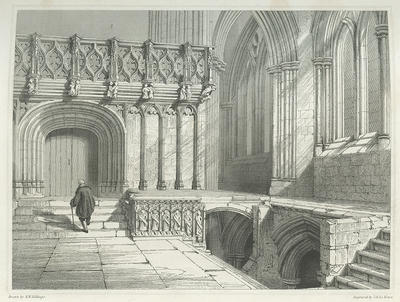
The west face of the choir screen in Glasgow Cathedral viewed from the nave looking east, as drawn by Robert Billings in 1847. To the right of it is the south transept, while the low arches (bottom right) mark the entrance to the crypt.
The choir screen, or pulpitum is believed to have been added in the 15th century. It virtually hides the choir from the nave. In medieval times, the nave was the part of the cathedral most used by lay people, while the choir was largely for the use of the clergy.
The screen is a solid stone wall with a central moulded doorway, with a low elliptical arch. Four panels of blind arches are on each side. Above is a balustrade with carved medieval figures at its base. The choir screen, also known as the rood screen, is the only screen of its kind left in any secular (non-monastic) Scottish church of the pre-Reformation period.
Reference: Mitchell Library, f720.941BIL
Reproduced with the permission of Glasgow City Council, Libraries Information and Learning
Keywords:
arches, balustrades, carvings, choir screens, choirs, crypts, Glasgow Cathedral, naves, pulpitum, rood screen, transepts
You have 3 images in your photo album.